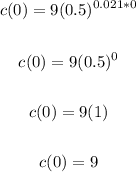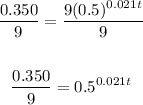Question 3.
Given the equation:

Where C is in milligrams per litre t minutes after taking the medicine.
Let's solve for the follosing:
• (a). Write down C(0).
To find C(0), substitute 0 for t and solve for c(0):

• (b). Find the concentration of the medication left in the patient's bloodstream after 40 minutes.
Substitute 40 for t and solve for C(40).
We have:

Solving further:

Therefore, the concentration after 40 minutes is 5.03 milligrams per litre
• (c)., To solve this, first substitute 0.350 for C(t) and find t:

Divide both sides by 9:

Take the natural loagraithm of both sides:

Therefore, the patient will take the medicine again 223 minutes after 14:00.
Convert the time to hours:
Where 60 mins = 1 hour

14:00 + 3:43 = 17:43
Therefore, the patient will take the medicine at 17:43
ANSWER:
(A). 9
(B). 5.02 mg per litre
(c). 17:43